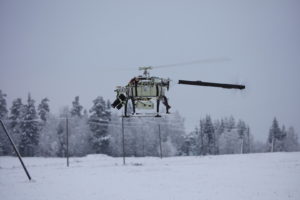
UAVOS announced a successful test flight of its SURVEYOR-HE Unmanned Aerial System equipped with an electric engine unit. The company says the new model increases performance with “carrying capacity, flying range, and extended temperature range.”
“The unmanned helicopter has high performance characteristics and is capable of flying at high altitudes in difficult weather conditions,” a UAVOS press release adds.
The multipurpose helicopter offers automatic take-off, flight and landing and can carry payloads up to 13 pounds. It features a maximum takeoff weight of 55 pounds and can fly up to 45 minutes. With a high-capacity battery option, the Surveyor can maintain flight up to 1.5 hours and can reach speeds up to 75 mph.
UAVOS investor and Board member Vadim Tarasov explains:
“The unmanned complex is all-weather, and can perform flights at temperature difference from -4F to 104F. Radius of data transmission in direct radio visibility in the basic configuration is 43.5 miles. Our complex implements retransmission of data on the command line, which significantly increases the area of safe operation of the complex. The EW countermeasure function makes it possible to carry out research operations in the conditions of jamming of satellite radio navigation signals and the command line channel.”
In addition, UAVOS is also offering up the Apus High Altitude Pseudo-Satellite control system for solar-powered drones. The system can also convert manned aircraft into unmanned and provide anti-electronic warfare rigs for drones.
Last year, UAVOS deployed a gas-powered drone to inspect oil refineries in Kazakhstan. Using an optoelectronic video surveillance system installed on a gyro-stabilized platform allowed users to video potentially dangerous objects from a safe distance and to transmit data in real time.
“It is one of our first projects in Eastern Europe to replace traditional methods of inspection in the oil and gas and energy sectors with robotic technologies,” Tarasov said. “Our solutions are intended to help our customers with enhanced safety of inspections, to reduce the budget, and to improving the quality of inspection of industrial territories.”
Jason is a longstanding contributor to DroneLife with an avid interest in all things tech. He focuses on anti-drone technologies and the public safety sector; police, fire, and search and rescue.
Beginning his career as a journalist in 1996, Jason has since written and edited thousands of engaging news articles, blog posts, press releases and online content.
Email Jason
TWITTER:@JasonPReagan
Subscribe to DroneLife here.